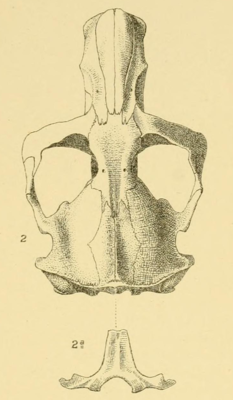Cratogeomys
| Cratogeomys | ||||||||||||
|---|---|---|---|---|---|---|---|---|---|---|---|---|

Yellow pocket rat skull ( Cratogeomys fulvescens ) |
||||||||||||
| Systematics | ||||||||||||
|
||||||||||||
| Scientific name | ||||||||||||
| Cratogeomys | ||||||||||||
| Merriam , 1895 |
Cratogeomys is a genus of rodents in the pocket rat family,with species primarily found in Mexico .
features
The species reach a head-trunk length of 14 to 26 cm, a tail length of 6 to 12.5 cm and a weight of 230 to 900 g. The soft fur is yellow, brown or black on top, while the underside is generally lighter. Occasionally there are white spots on the fur. These pocket rats have a deep groove on the front of each upper incisor that continues slightly on the inside. According to another description, almost all specimens have a full groove on the inside.
Types and distribution
According to IUCN (2008), the following seven species belong to the genus.
- The yellow-faced pocket rat ( Cratogeomys castanops ) lives in northern Mexico and the western United States , north to Colorado and Kansas .
- The yellow pocket rat ( Cratogeomys fulvescens ) occurs in an endorheic basin ( Oriental Basin ) in central Mexico.
- The sooty pocket rat ( Cratogeomys fumosus ) has several separate populations in central Mexico.
- The Goldman pocket rat ( Cratogeomys goldmani ) inhabits deserts and semi-deserts in northern Mexico.
- The Merriam pocket rat ( Cratogeomys merriami ) lives in the southern outskirts of Mexico City .
- The Cofre-De-Perote pocket rat ( Cratogeomys perotensis ) is native to mountains east of Mexico City.
- The Toluca pocket rat ( Cratogeomys planiceps ) can be found in mountains west of Mexico City.
Taxa that were recognized as separate species in Mammal Species of the World (2005) are synonymous with the sooty pocket rat.
Way of life
These pocket rats have adapted to different habitats. They occur in deserts and semi-deserts, in grasslands, on areas with palm trees and in mountain forests with firs and spruces . Some populations reach areas that are 3,700 meters above sea level.
Like other pocket rats, the animals dig underground tunnel systems with the help of their clawed front paws and incisors. Similar to moles , they throw up mounds with a diameter of 30.5 to 91.5 cm. The burrows are generally deeper than those of the mountain pocket rats ( Thomomys ), with whom they often share their territory. A typical structure consists of a 3 to 6 meter long corridor that lies on average 28 cm below the surface of the earth, as well as several side tunnels that are 0.3 to 3.0 meters long. The last section of the main tunnel slopes downwards. Various chambers are connected to the corridors, as storage for food or as a grass-padded dwelling.
Various plants that occur in the distribution area serve as food, such as B. Cacti .
The breeding season for southern species extends throughout the year and for northern species from January to October. There are 3 to 4 litters a year, most of which consist of twins. Females born in spring can produce their own offspring in autumn. Most females do not live to be more than 56 weeks old. In males, life expectancy is a maximum of 31 weeks.
Cratogeomys and humans
The species are considered pests by farmers because they often eat vegetables, grains or potatoes. Like the giant gophers ( Orthogeomys ), they are of special bag Pied Piper ( Tucero hunted). The IUCN lists all representatives of the genus as "not endangered" ( Least Concern ).
Reference literature
- Ronald M. Nowak: Walker's Mammals of the World. 2 volumes. 6th edition. Johns Hopkins University Press, Baltimore MD et al. 1999, ISBN 0-8018-5789-9 .
- Clinton Hart Merriam: Revision of the pocket gophers, family Geomyidæ, exclusive of the species of Thomomys . In: North American fauna . No. 8 , 1895, p. 1-262 ( biodiversitylibrary.org ).
Individual evidence
- ↑ a b c d e f Ronald M. Nowak: Walker's Mammals of the World. Volume 2. 6th edition. 1999, pp. 1316-1318.
- ↑ a b c Cratogeomys in the IUCN Red List of Threatened Species 2012. Accessed September 10, 2016.
- ↑ Don E. Wilson , DeeAnn M. Reeder (Ed.): Mammal Species of the World . A taxonomic and geographic Reference . 3. Edition. 2 volumes. Johns Hopkins University Press, Baltimore MD 2005, ISBN 0-8018-8221-4 (English, Cratogeomys ).